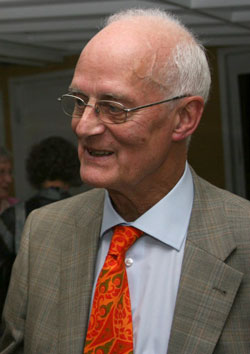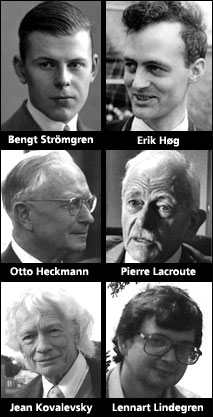Astrometry in space
Erik Høg wrote a number of articles about his experiences with photoelectric astrometry and in 1975 ESA asked him whether he would take part in the development of a satellite for astrometry.
The French astronomer Pierre Lacroute had worked for many years with this great vision and with plans, which seemed quite unrealistic to Erik Høg. Consequently, he had no prior interest, but nevertheless agreed to take part.

However, already at the first meeting in Paris he was excited about the cause, because the chairman said that they should not even think about the existing plans, but only about how they could best utilize the possibilities of space techniques for science.
So Erik Høg could suddenly think completely freely and even though he had never been interested in space technology he made a new design for an astrometric satellite in six weeks.
Catalogue of the stars in the sky
It was a completely new design, which quickly became a hit and led to collaboration with astronomers from all over Europe and with engineers within ESA and in the industry.
The satellite Hipparcos was adopted in 1980 and launched with an Ariane rocket in 1989. The results were published in 1997 and have since revolutionised many areas of astronomy.
Three years later they were able to publish a catalogue called Tycho-2 with 2.5 million stars. It has become the most widely used catalogue of bright stars in the sky for use in astronomy and for controlling the movement and rotation of satellites in space.
He chose the name Tycho after Tycho Brahe in 1981 when he thought of some additional measurements that should be made using the Hipparcos satellite.
The suggestion of additional measurements came a year after the satellite's adoption and at that time they would normally say: "you are just too late." But the proposal gained such support that the extra millions were allocated so that the necessary changes in the design could be built in.
The name Tycho was also adopted and "I was very pleased with that", explains Erik Høg, who had suggested the name Tycho for the satellite he proposed in 1975, but which was changed to Hipparcos to recall the Greek philosopher Hipparchos (190-120 BCE), also known as the father of astronomy.
Astrometry from 1925 to 1980

Six key astronomers
The development of astrometry from 1925 up to ESA's adoption of the Hipparcos mission in 1980 was very dependent on very few, because astronomers considered astrometry as less exciting in comparison with astrophysics. Six astronomers in this period each played a crucial role in the development.
These are the two Danish astronomers Bengt Strömgren and Erik Høg, Otto Heckmann from Germany, the two French astronomers Pierre Lacroute and Jean Kovalevsky, and the Swedish astronomer Lennart Lindegren. Had just one of them been missing, this development would have stalled.
